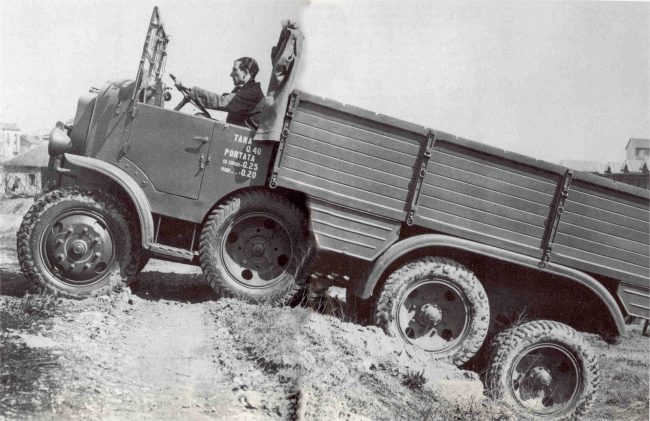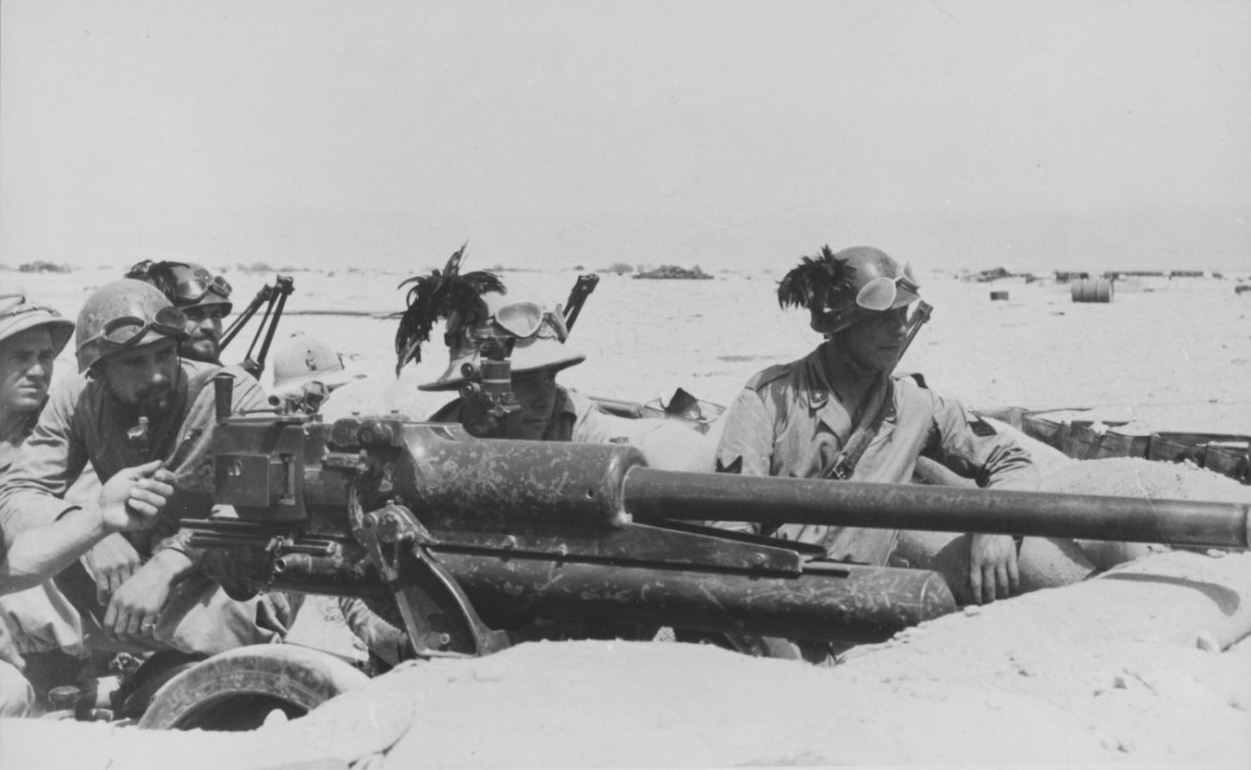Gazala 1942:
The Motorized Divisions
by Mike Bennighof, Ph.D.
October 2016
The Royal Italian Army’s vision of a mechanized army included infantry divisions that would ride to battle in trucks or, preferably, armored tracked carriers. Just like the formation of armored divisions, that part of the program proceeded far more slowly than the army command wished. Italian industry did a much better job making trucks than tanks, both in quantity and quality, but even so could not produce enough vehicles.
Two motorized infantry divisions formed in 1935, the 8th “Po” and 1st “Trento,” later re-numbered 32nd. Each division had two regiments of infantry, one of Bersaglieri and one motorized artillery regiment. They participated in maneuvers in the Po Valley with the two armored brigades, later raised to division status, as the Italian Army worked out its mobile doctrine.
In the 1939 and 1940 the Army embarked on a re-organization of its motorized forces. Three infantry divisions (9th “Pasubio,” 10th “Piave” and 52nd “Torino) became “semi-motorized” units, in which the infantry marched on foot but the division had enough trucks to move its artillery and logistical services or to motorize some of its infantry, as the command staff found necessary.

A Fiat Dovunque truck shows off its off-road abilities.
The two fully motorized divisions underwent re-organization as well. They kept their Bersaglieri regiments, but their infantry regiments had only two battalions plus a mortar company, instead of the three battalions common to standard infantry regiments. To make up for that they had a divisional heavy weapons battalion with more mortars, anti-tank guns and machine guns. The two divisions shuffled their infantry regiments and took on new numbers, 32nd “Trieste” becoming 101st “Trieste” with the 65th and 66th “Valtellina” infantry regiments plus 9th Bersaglieri Regiment and 8th “Po” Division becoming 102nd Trento with 61st and 62nd “Sicilia” infantry regiments plus 7th Bersaglieri Regiment.
Both divisions moved to Italy’s north-western frontier in the late spring of 1940 and fought in the brief campaign against the French. Afterwards they returned to northern Italy to continue training; the Trieste Division’s 21st Motorized Artillery Regiment went to Albania in November 1940 and returned to the division in the following summer.
The 102nd “Trento” Motorized Division received orders to deploy to North Africa in March 1941, to join the 132nd “Ariete” Armored Division (which had moved to Libya in January and February) in a new Italian motorized corps. The division fought in the Axis counter-offensive across Cyrenaica, fighting very well at the battles around Halfaya Pass later that spring and in resisting the Allied offensive known as Operation Crusader in November 1941. At the Battle of Gazala the Trento Division gave up its trucks and fought on foot as part of the Italian X Corps. That would doom the division six months later at Alamein, when it was unable to escape for lack of transport and was destroyed.
The 101st “Trieste” Motorized Division received its orders for the North African theater in August 1941, arriving at the front lines (then in eastern Cyrenaica) in October. Trieste saw its first extensive action during Operation Crusader where it performed well, and in the Axis counter-offensive that followed. During the Battle of Gazala the Trieste Division attacked to the north of the Free French positions at Bir Hacheim and ended up bogged down in heavy fighting with the exiles. The British broke through the 65th Infantry Regiment during the Battle of El Alamein, helping to start the Axis retreat that finally ended in Tunisia. Trieste made it back to that French colony and fought the Allied armies until the final collapse of the Axis position in Africa in May 1943.
The Trieste Division served as the testing ground for the proposed “AS 42” reorganization of the Italian infantry into combined-arms teams. The 9th Bersaglieri were detached to serve directly under higher command (as occurred with Trento’s 7th Bersaglieri). The two infantry regiments were each re-organized from the standard three identical infantry battalions into two rifle battalions and a heavy weapons battalion, with additional machine guns, medium mortars and anti-tank guns intermixed with the riflemen. This organization greatly reduced the number of infantrymen but substantially increased its firepower thanks to the high proportion of automatic weapons and 47mm anti-tank guns, which also had an excellent high-explosive round. While some sources claim that Trieste maintained its divisional heavy weapons battalion as well as the two regimental battalions, this does not appear to be true.

An Italian 47mm anti-tank gun manned by Bersagliere.
By the time of the Alamein battles the division also had its own tank battalion with M13/40 medium tanks, and a battalion of Bersaglieri-manned armored cars (mostly equipped with captured British vehicles). The artillery regiment had been beefed up with more 100mm guns, which also saw use in an anti-tank role when needed, and a battalion of German-made 88mm anti-aircraft guns (these last do not appear to have been fully issued).
Transport remained a weakness; Trieste did not have enough of the excellent Fiat 666 Dovunque all-terrain trucks and made do with standard vehicles that offered poor off-road performance – and almost all of the division’s movement in the North African theater took place off roads. The Royal Italian Army had a great deal of experience in the Libyan desert thanks to its campaigns against the Senussi, and had designed an armored all-terrain wheeled Dovunque that could carry infantrymen directly into battle and also tow small artillery pieces (the 47mm anti-tank gun and 20mm anti-aircraft gun). But this vehicle never entered series production. Eventually Trento was to receive the same organization as Trieste, but the additional weapons, vehicles and tanks did not make to the North Africa before the division was destroyed.
While the new organization produced divisions less than half the size of a British infantry division, it reflected the lessons of desert warfare far better than those of any of the other participants. The 47mm gun could still deal with almost any Allied tank at the time the new tables were drawn up (the American made Grant and Sherman would severely test its capabilities), and the big dual-purpose 88mm guns could deal with anything in the Allied arsenal. The organization would be short of infantrymen, but this wouldn’t have been a serious shortcoming in the open desert, where firepower counted for much more and close-range fighting would be far rarer than in denser environments.
Both the Trieste and Trento divisions appear in our Gazala 1942 game, and in our Heat Wave 2016 Golden Journal they’ve received their post-Gazala upgrades with real laser-cut and mounted playing pieces (both actual and planned). They are very capable, if small, formations as upgraded and play a major role in the Journal’s additional scenarios.
Click here to order Gazala 1942.
And click here to join the Gold Club
Mike Bennighof is president of Avalanche Press and holds a doctorate in history from Emory University. A Fulbright Scholar and award-winning journalist, he has published over 100 books, games and articles on historical subjects.
He lives in Birmingham, Alabama with his wife, three children and his dog, Leopold.
|
